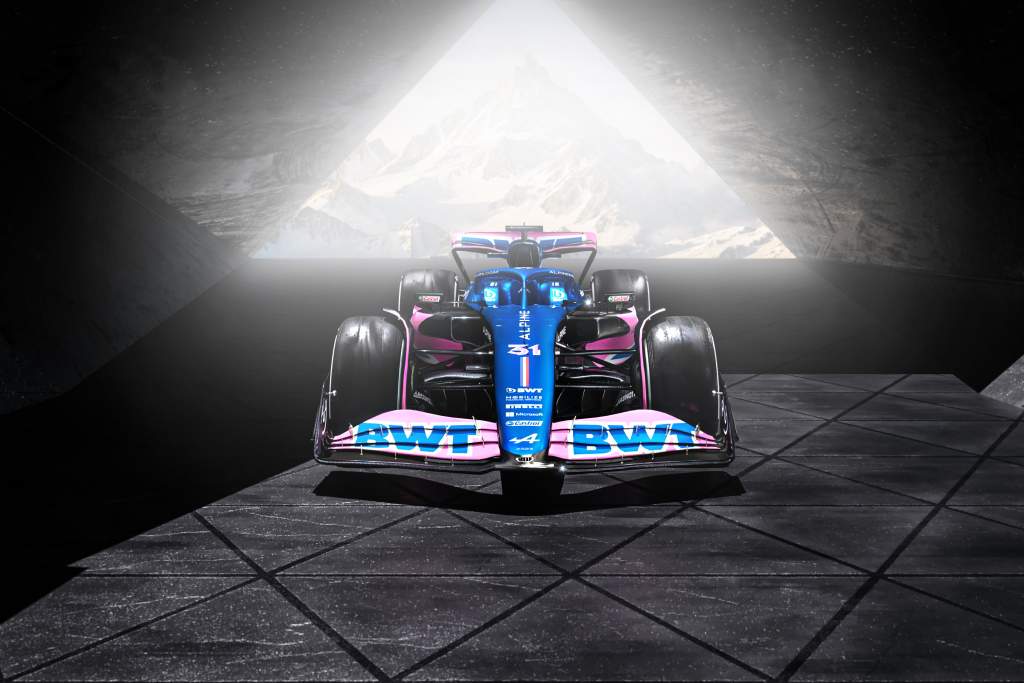Up Next

The Alpine launch may have dragged its feet with the road cars, especially the police car scene, but it was interesting to hear about the team’s objective. It’s very clear the team’s management are really focused on bringing Alpine to the fore in Formula 1 and, from what I’ve seen of the car, it is on track to reduce that gap to the top three.
While the launch could have been sharper, it does set the tone for the season to come. And I think presenter Vicky Hope brought a lot of ‘hope’ to Alpine by doing a great job.
We also saw Pierre Gasly and Esteban Ocon together. They have a difficult history but I think this will be a better partnership than Fernando Alonso and Ocon because they bring less pressure and will allow everyone in the team to express themselves. Yes, there will inevitably be some intra-team frustrations, but that’s all sortable. Team principal Otmar Szafnauer might have to be ‘Mr Nasty’ on a few occasions, but for the right reasons.
As a works F1 team, Alpine should be up there winning races and fighting for championships. But while it’s lovely to dream of winning races, first you have to close the gap to the big boys. That’s what this season is all about.
The Alpine A523 does look pretty good. It’s definitely a car that stands on its own more than some of the others. Yes, there is a trend, but that is basically because of very defined regulations so it’s nice to see a team stick by its design convictions.
Technical director Matt Harman was very confident in presenting the overall vision for the car. Talking through it from front to back (albeit not using the actual 2023 car to do so), he was very confident Alpine has addressed each and every area and that the end result is a positive step in all areas.
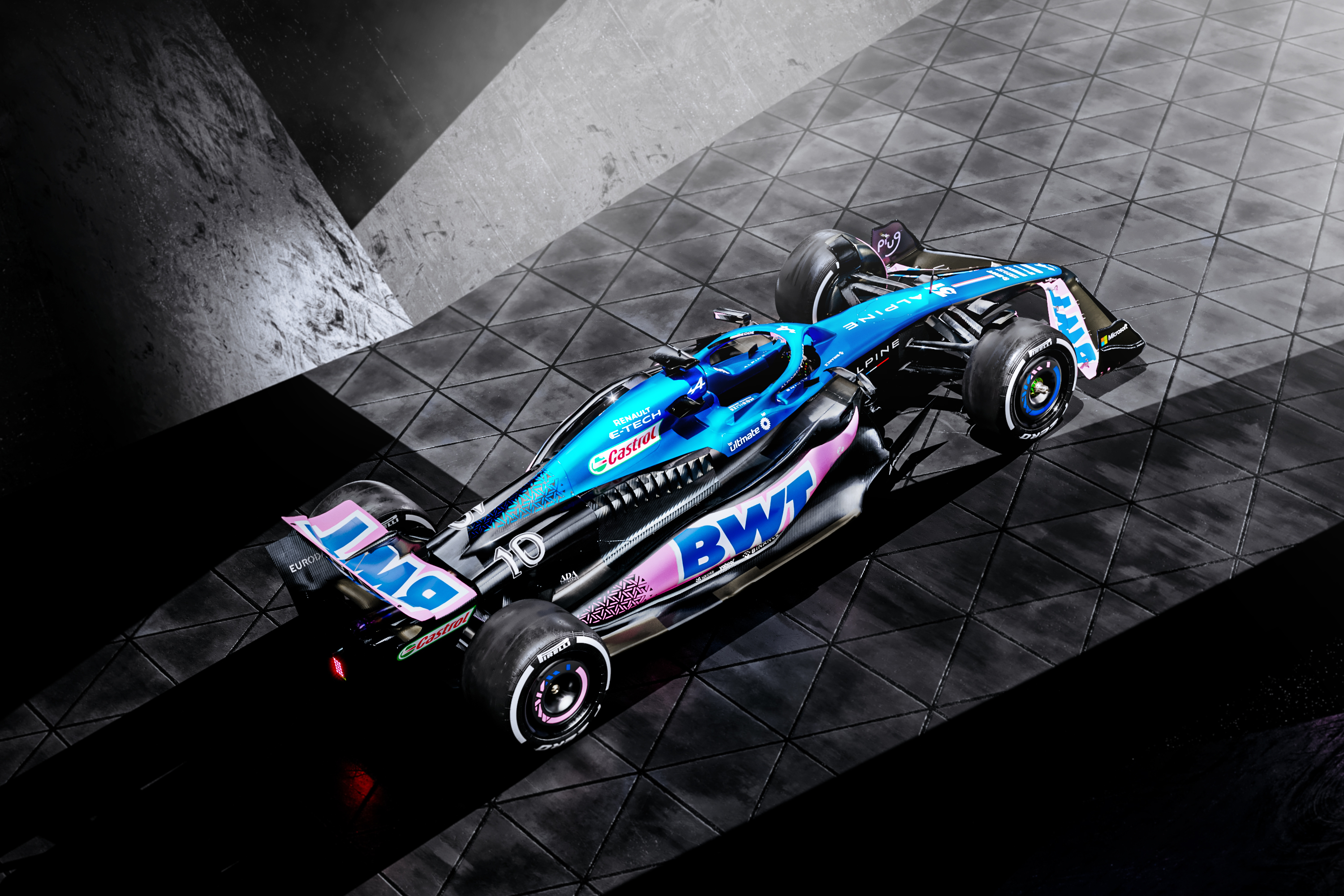
I agree with that statement. There is no single magic bullet, it is about optimising each and every detail. Even now with the car just released, Alpine will have an ever-growing list of what could be done better. The car has already been shaken down on a filming day, but when the car first runs in pre-season testing that list will get prioritised and the cycle will start again to form the development programme.
So let’s take a look at the car, with the usual caveat that these are pictures released by Alpine. That means they could very easily be doctored or misleading.
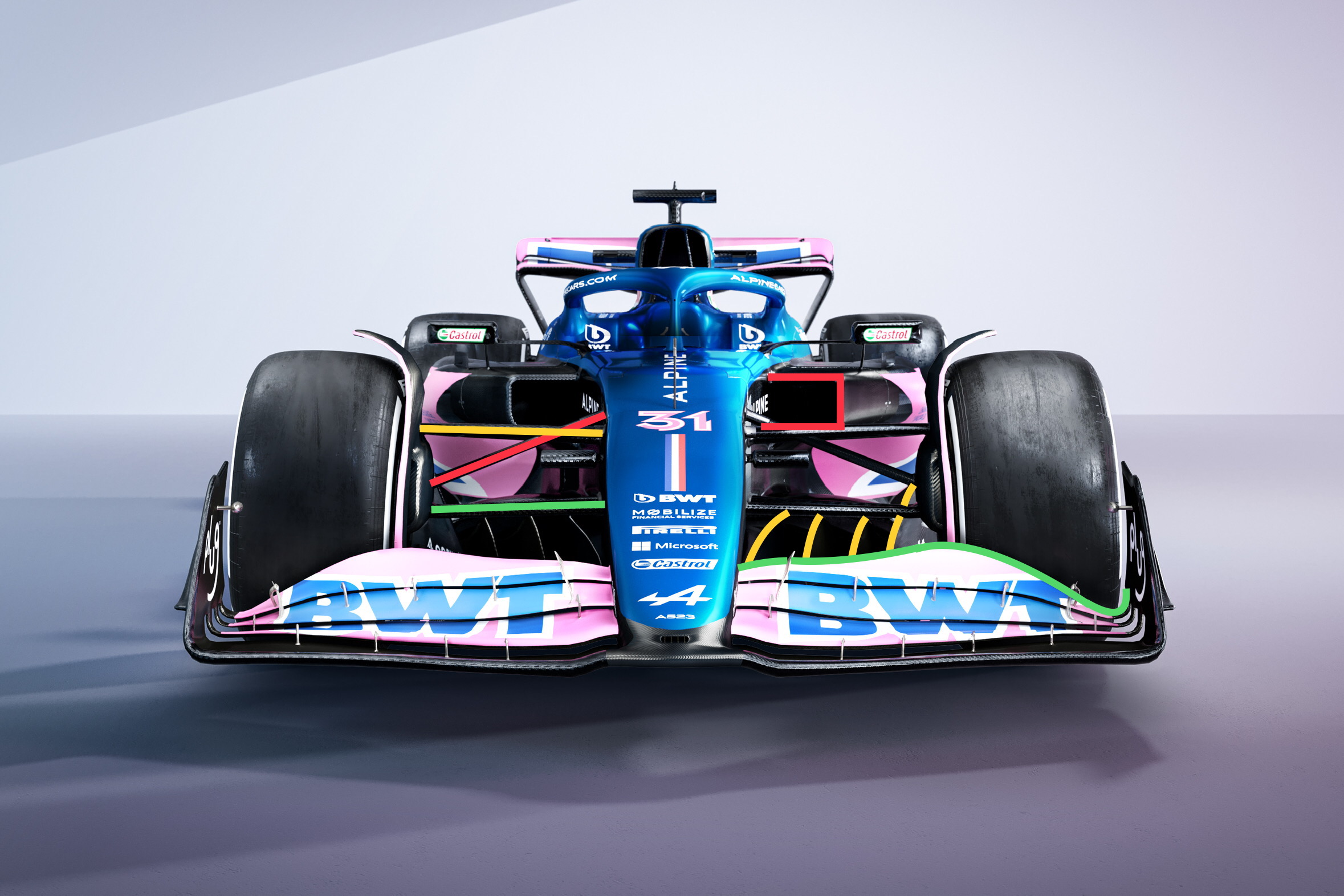
Looking at the car from head-on, the front wing trailing edge (green highlight) is fairly evenly loaded across its span. The flaps then drop away quickly to the endplate lower corner, which together with the tyre squirt will generate some outwash. Albeit with a little variation, this seems to be the trend that all the teams have followed.
That’s all fine, but when everyone is doing the same thing it means there is very little room to get an advantage with just the geometry of the component so, unless you come up with something completely new, this area is here to stay.
Alpine doesn’t have a full width slot gap between the forward and second element of the wing assembly. Not having this can create problems in keeping the airflow attached to the rising underside of the nose. If you get flow separation in this area, it can affect the flow to the central part of the underfloor leading edge and, in turn, affect the diffuser efficiency further downstream.
The leading edge of the underfloor splitters (yellow lines, above right) are all fairly equally spread. All four of these will turn outwards to force airflow out of the side of the car.
With the high pressure on the face of these splitters and low pressure on the back of them, it will create a series of vortices that will be shed off their lower edge into the underfloor area. This will help re-energise the airflow across the throat of the underfloor tunnel.
It is the airflow inside of those inner splitters on each side that will feed the underfloor. This will be pulled in there by the diffuser. Its speed will be increased to generate the low pressure that creates the downforce underneath the car, so it’s important that there are no separation problems created from turbulence under the nose further upstream.
The radiator intake is very rectangular, with a small fillet radius on the top corner and a slightly larger fillet radius on the bottom corner. Overall, it is quite a small opening, so as long as the air expansion rate within the duct doesn’t create any separation problems it should be fairly efficient and not suffer from too much airflow spillage at high speed.
However, with this small entry the most efficient cooling will be at a higher car speed than some other cars that we have seen that have larger cooling openings.
As last year, the suspension is a fairly simple top (yellow highlight) and bottom (green highlight) wishbone with the inner suspension components operated by a pushrod (red highlight). A comparison of this year’s and last year’s configurations can also be seen below.
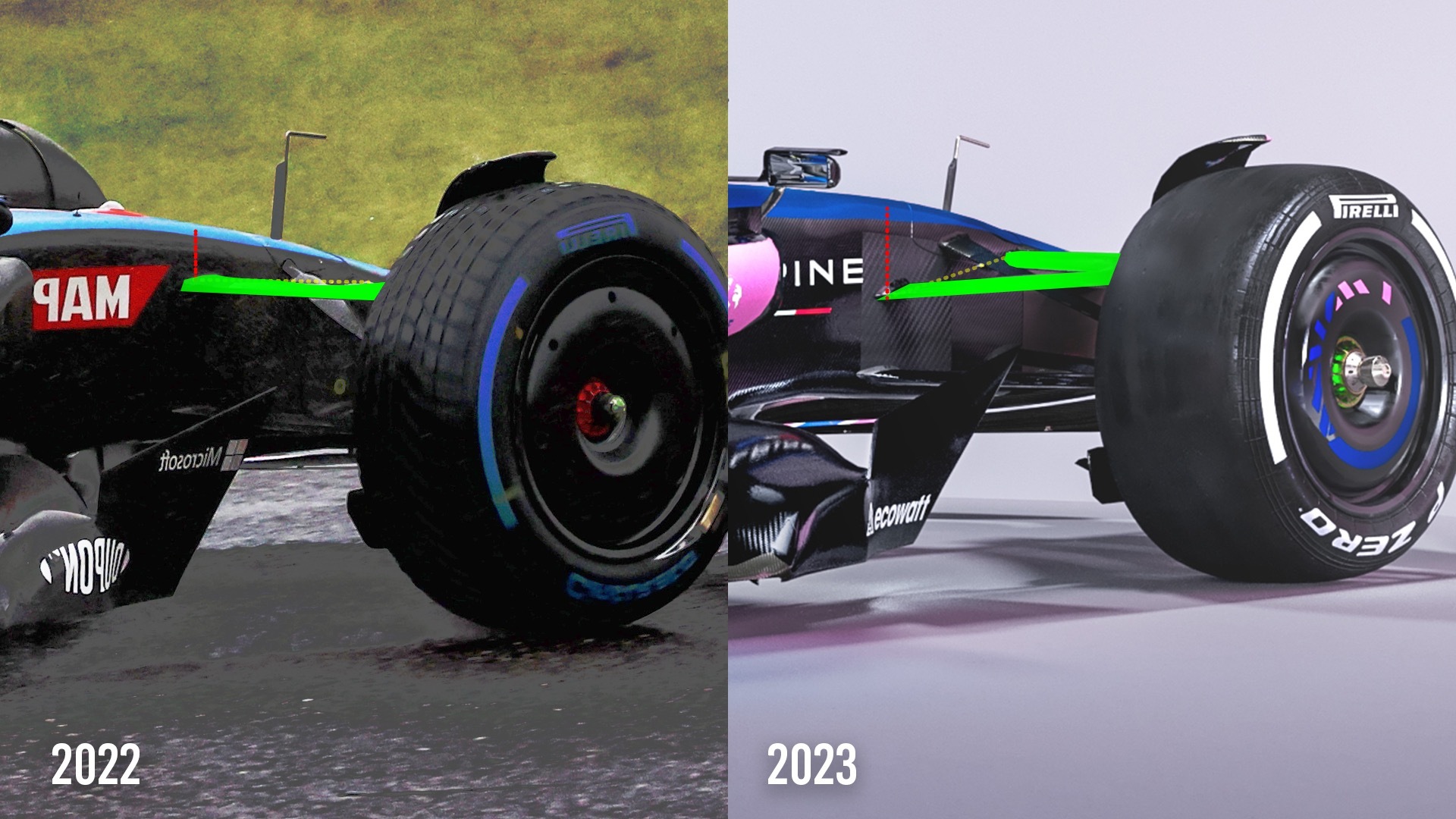
There doesn’t appear to be any anti-dive or anti-squat on the wishbone geometry, so Alpine will be relying on the car stiffness and the third spring element to support the changing lateral loads under braking and accelerating.
It’s difficult to see in these pictures, but I’m pretty sure the front trackrod is in line with the bottom wishbone forward leg.

One of the interesting features we see on the Alpine is this ‘gully’ in the top surface of the sidepod. In the side view, you can see the sidepod top surface (green highlight) but inside of that there is this ‘gulley’ (orange highlight).
Alpine brought this in with one of its updates last year and so far we have only seen Aston Martin follow suit. It is not unlike the Ferrari ‘bathtub’ sidepod top surface and is just a bit more aggressive.
With this style of sidepod top, Alpine is trying to reduce the amount of airflow that could spill over the top corner of it and into the Coke bottle area, which would have a negative effect of the underfloor performance by allowing more leakage along its edges.
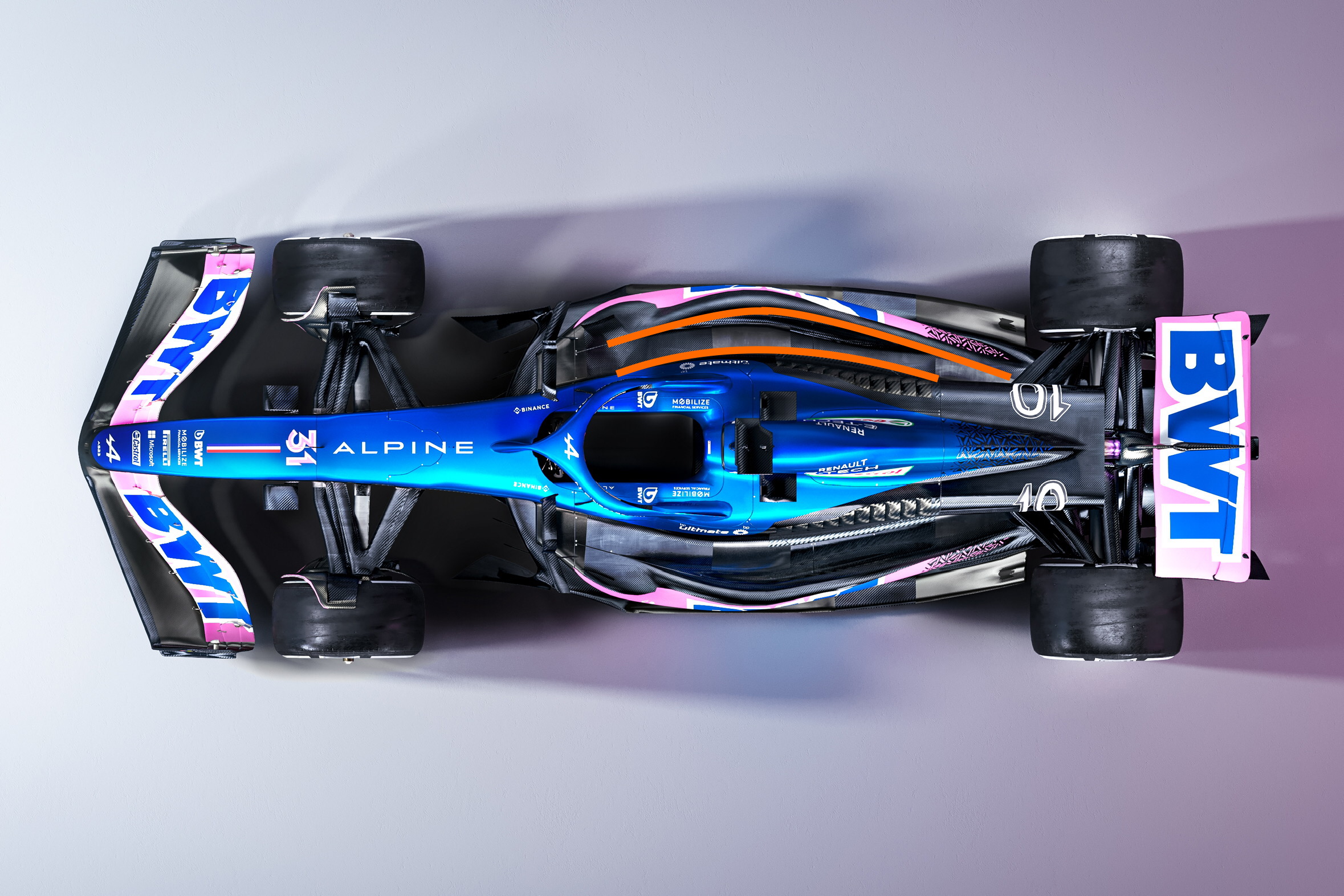
It will also help to get more airflow to the central part of the car underneath the radiator exit openings that are alongside the exhaust outlet – getting this flow as far inboard as possible will help the performance of the diffuser.
The rear suspension is pushrod-operated, but in these pictures there appear to be more suspension links than you would really need. To get more detail of this, we will have to wait until pre-season testing starts and we get one of our eagle-eyed photographers to take a few snaps.

In this rear view, we can see that the radiator exits (red highlight) are bigger than we have seen so far on other cars. That would be in line with what I said earlier about the inlet being smaller than expected. We will only know how correct the team’s cooling calculations were when we get to some high ambient temperature circuits.
The exhaust outlet is highlighted in yellow. Its location is defined in the regulations with the objective of reducing the gasflow effect on any aerodynamic surfaces. Having the radiator exit in this area means the high-speed exhaust gases help draw air through the radiators, improving the cooling.
The diffuser trailing edge (blue highlight) shows the extent of the diffuser expansion. Again, this area is defined in the regulations and all the teams maximise it. The diffuser pulls the airflow in front of the leading edge of the central part of the floor and speeds that airflow up to generate the low pressure underneath the car and, as such, the underfloor downforce.
Any leakage along the sides of the floor will have a detrimental effect on the increase in airspeed and reduce that potential underfloor downforce.
Just inside the rear tyre (magenta highlight) is the winglet ramp area on the side of the rear brake ducts. This again works like a small diffuser, picking up the inner tyre squish airflow and stopping it leaking into the diffuser – which would otherwise reduce its performance.
Actually, these small winglets mounted on the brake duct are very important because they produce their forces directly on the upright assembly, which in turn does likewise for the tyre contact patch.
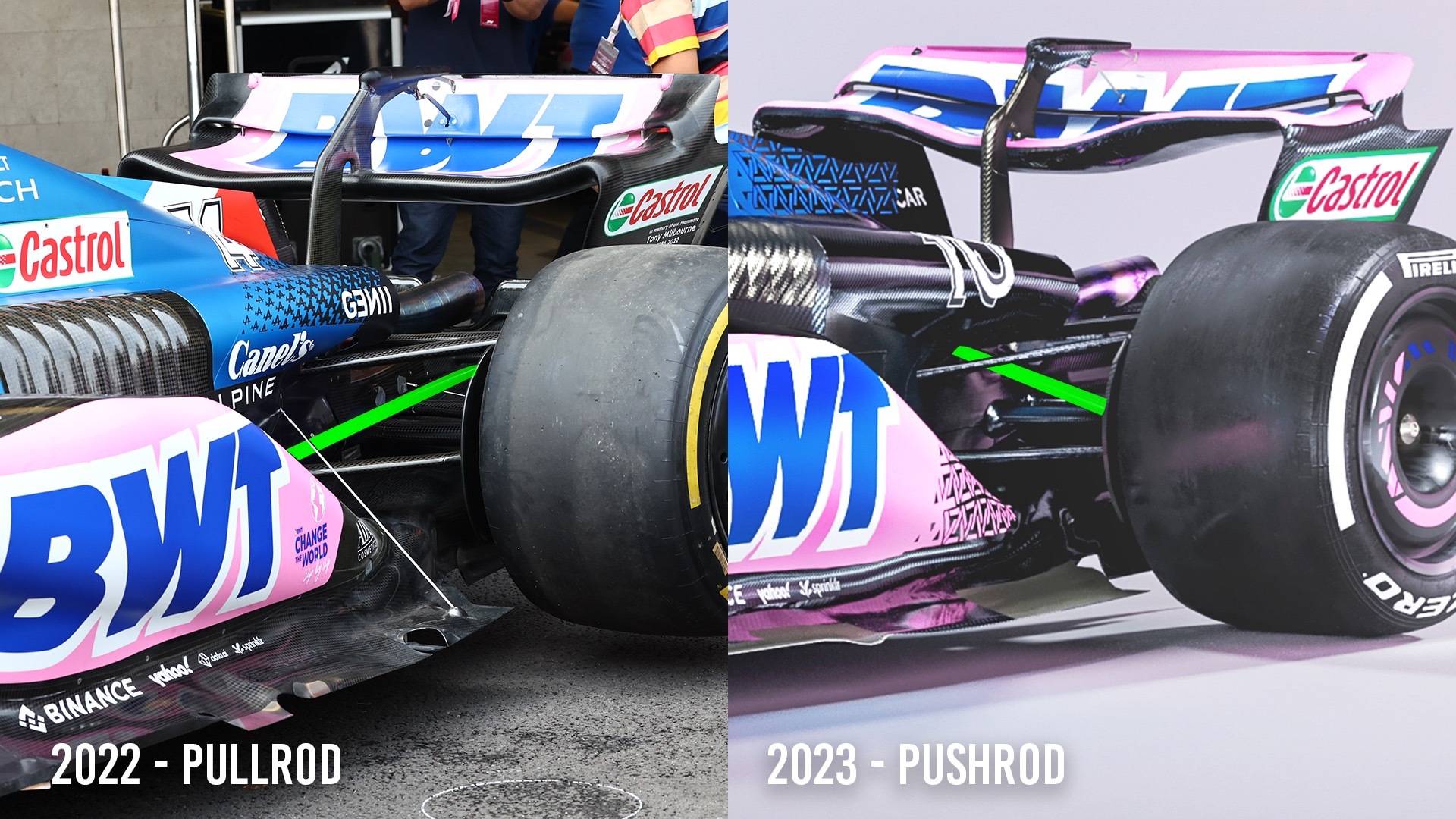
The downforce produced by the sprung parts of the car, underfloor and wings goes through the suspension medium so if the rear of the car is moving up during braking the tyre load is momentarily reduced.
These vanes being mounted directly on the upright assembly don’t suffer with that problem so the more load you can get from them the more stable the rear of the car will be under braking.
The big question is, has Alpine closed the gap to the big three? The first test at Bahrain is just around the corner, so it won’t be long before we get a first indication.


